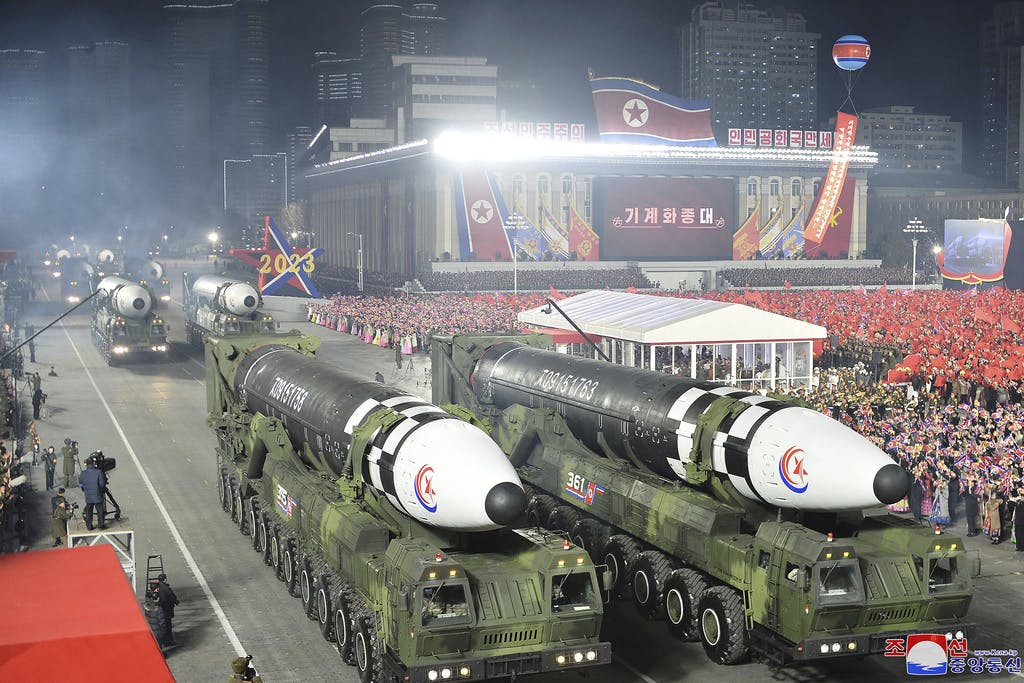‘Axis of Evil’ Is Back at Work in Battle of Drones Over Iran
Tehran’s relations with Pyongyang echo what President George W. Bush called the ‘axis of evil.’

Iran may have deployed North Korean weapons Friday in defense of its air base and nuclear facilities at Isfahan, about 220 miles south of Tehran — offering the latest evidence of President George W. Bush’s dictum in 2002 that those two villains were bound in an “axis of evil.”
The targets reportedly were Israeli drones sent over Iran in retaliation for Iran’s assault on Israel on Saturday with 300 missiles and drones, most of which were shot down by Israeli, American, and Jordanian forces, but the scenario of strike and counter-strike was surely far from done.
Neither Saturday’s attack nor Israel’s response Friday caused much damage but provided a foretaste of worse to come. North Korea is shipping arms and ammunition, including missiles and drones, to Iran via Russia and China, according to South Korean intelligence sources. Neither Russia nor China are enforcing UN Sanctions against Iran.
“Iran has warned Israel it is likely to review its nuclear stance if its atomic facilities are threatened,” the Financial Times reported Friday. The paper said Iran’s Revolutionary Guard has warned “Tehran may ‘reconsider’ its nuclear policy” — now “on the threshold of becoming a weapons state.”
At the heart of the anti-Israel forces, the axis linking America’s two key foes in Asia and the Middle East, North Korea and Iran, is stronger than ever as war flares in both Gaza and Ukraine and tensions rise in Asia. The difference is that Iraq, which Mr. Bush included in the axis, is no longer a menace since the Americans drove Iraqi forces from Kuwait in 1991 and in a subsequent invasion captured Saddam Hussein in 2003.
Now South Korea’s National Intelligence Service wants to confirm if the ballistic missiles fired by Iran against Israel were made in North Korea. The NIS, in a statement to the South Korean press, said it was “keeping tabs on whether the North Korean technology was included in Iran’s ballistic missiles launched against Israel, given the North and Iran’s missile cooperation in the past.”
Iran has acquired North Korean technology for its Scud missiles, according to a leading analyst on North Korea’s nuclear-and-missile program, Bruce Bechtol, and Iranian observers attend North Korean missile launches as observers. .
For starters, Mr. Bechtol, author of numerous books and studies of North Korean and Iranian military strength, told the Middle East Eye, “Iran still relies heavily on North Korea for conventional arms.” Beyond that level, he said “North Korea’s missile programs are far ahead of Iran’s..”
North Korean armaments, including missiles and drones, are assumed to have been designated for Iran before going by train or boat to Russian far eastern ports, according to NIS contacts.. The shipments are among 10,000 containers that the State Department says North Korea has sent to Russia since Kim Jong-un met President Putin at the Vostochny Cosmodrome on the Amur River in Siberia last September.
The North Koreans are presumably reluctant to risk shipping weapons by sea while American warships lurk in nearby international waters, but Mr. Kim counts on Russian cooperation to get arms through to Iran while also serving the voracious needs of Russian forces in Ukraine.
The ease with which North Korean weapons flow into and through Russia was guaranteed by Russia’s veto of a bid to renew a panel of experts that the UN Security Council had formed in 2009.
The purpose of the panel was to monitor UN sanctions, as the executive vice president of the Peterson Institute for International Studies, Marcus Noland, explains “China and Russia have sought to end sanctions on North Korea,” he writes, while the UN panel produced “authoritative evidence on North Korean sanctions evasion activities and member states’ implementation (or non-implementation).”
Iran may no longer be flooding Hamas with arms and ammunition as it was doing before the war in Gaza, but there’s no doubt it’s relaying them to its Hezbollah surrogate in Lebanon and to the Houthis in Yemen.
More importantly, many of the missiles and drones that Iran fired into Israel may have been North Korean. North Korean export of weapons to bad actors in the middle east goes back decades — and is believed to have increased exponentially in recent months.

